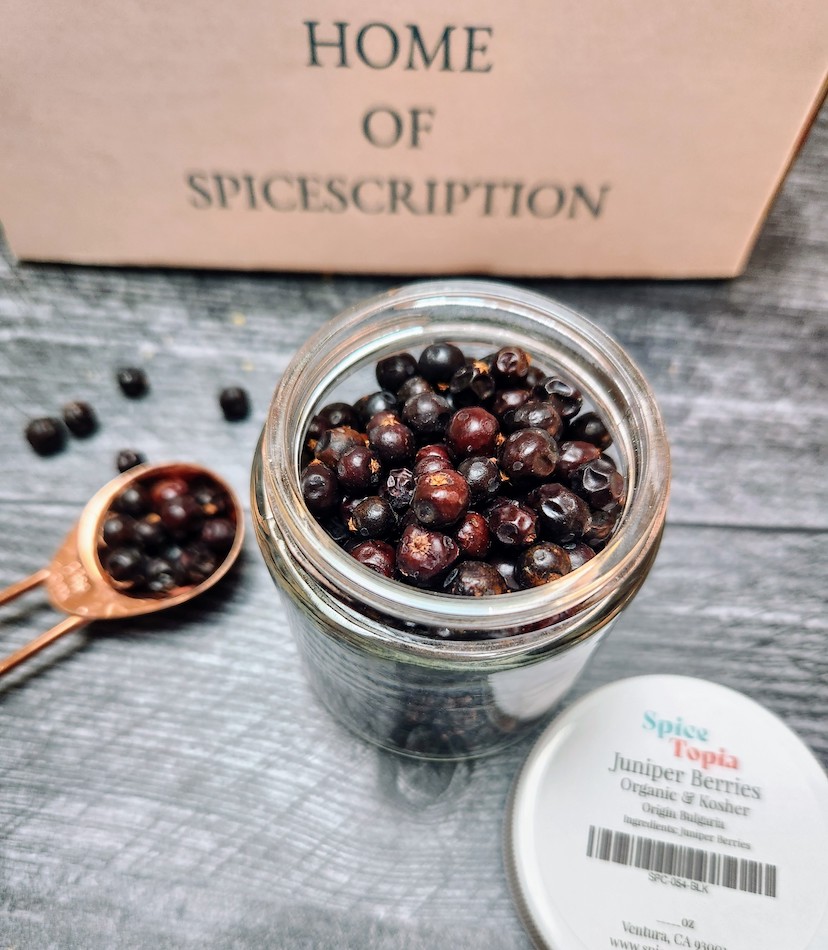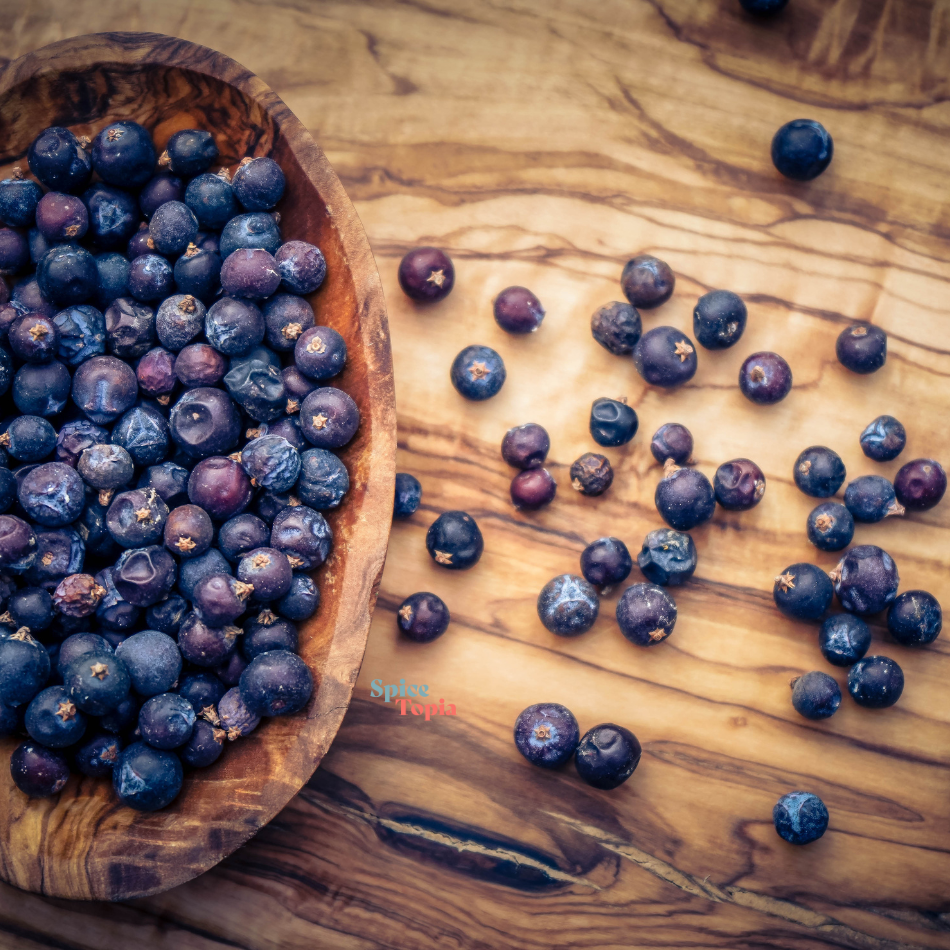Juniper Berries are an interesting spice that is most well known for their role in making gin and aquavit! It is also often found in pickling brines.
With a complex flavor combination of sweet, savory, and bitter, with hints of citrus, clove, and cinnamon, this is a spice that has so much more to add to cuisine than gin!
What Do Juniper Berries Taste Like?

Juniper Berries have a clean, fresh, and quite sweet flavor with notes of pine and citrus.
Lightly crush them before cooking to release their flavor. When crushing them, they will be slightly oily and sticky. This means the berries are fresh and full of essential oils which provide their distinct flavor.
You may see a bloom (or white coating) on Juniper Berries. This is a naturally occurring yeast, and in Northern and Central Europe this yeast is often used in creating sourdoughs as well as the fermentation process of creating sauerkraut.
What’s Up With Gin and Juniper Berries?
Juniper Berries became the main ingredient in gin during the Eighty Years’ War when the Norwegians were fighting for independence from Spain. This new spirit was intended to help calm the anxious soldiers!

How to Cook with Juniper Berries?
Juniper berries can be used in a variety of dishes, both savory and sweet. Here are four ways to use juniper berries when cooking:
- Sauces: Juniper berries are a wonderful way to flavor sauces, such as gravy, barbecue sauce, and cranberry sauce. Crush before adding and if not blending your sauce, remove before serving.
- Meat: Juniper berries are a popular seasoning for game meat, such as venison, rabbit, and duck. They can also be used to flavor poultry and pork.
- Fish: Juniper berries add a wonderful flavor to oily fish such as salmon, mackerel, swordfish, and herring.
- Vegetables: Juniper berries can be used to flavor vegetables, such as carrots, cabbage, potatoes, and onions. They can also be used to make a vinaigrette for salads.
- Chocolate: We love the zippy fruity taste of juniper berries combined with the bitter notes of chocolate! Crush a teaspoon up, and add to your next chocolate cookie recipe. You won’t be disappointed– we promise!
When using juniper berries, it is important to use them sparingly. They have a strong flavor that can easily overpower other flavors. A good rule of thumb is to use no more than 1 teaspoon of juniper berries per pound of meat or fish.
Where to Buy Juniper Berries?

SpiceTopia offers Juniper Berries as well as Pickling Spice which includes Juniper Berries.
The History of Juniper Berries
Juniper Berries appear in ancient texts as widespread as Ancient China, Egypt, Romans, and Greeks. An oral history of Juniper Berries also exists in many indigenous peoples across North America.
Across all these cultures the use of Juniper Berries was extremely varied.
Those in Central and Northern Europe used Juniper Berries to treat digestive issues such as stomach aches, diarrhea, and kidney stones as well as a preservative for meats and cheeses.
In China, traditional medicine considered Juniper Berries essential for flushing out impurities and toxins. Juniper was also considered an important herb for healing infections.
The Ancient Romans had a much simpler and straightforward way to utilize Juniper Berries. It was a replacement for expensive and hard-to-procure peppercorns!
While in Greece, Juniper Berries were considered an important part of maintaining physical stamina for athletes and warriors.

Just like those living in Central and Northern Europe, Egyptians used Juniper Berries as a preservative – although not for something one would want to eat! Egyptians saved juniper berries for the dead as they were part of their embalming recipe.
During the Black Plague, juniper branches were burned to kill the germs in the air. The doctor’s bird-shaped mask had a beak stuffed full of juniper berries which was believed to filter out germs before the doctor could breathe them in.
Current Western Medicine’s wisdom acknowledges that Juniper Berries are full of Vitamin C as well as antioxidants. Studies are still being conducted to test the powerful antibacterial and antifungal properties as well as how Juniper Berries may help fight diabetes.
Where Do Juniper Berries Come From?
So now that we know Juniper Berries have been around “forever”, just where do they come from? How are they grown?
Although we call this spice a berry, it is actually a seed cone of an evergreen tree! These cones are unusually fleshy with merged scales, which gives them a berry-like appearance. When you slice into them, you’ll see that they aren’t berries at all.
Juniper Berries are the only spice that grows on an evergreen tree, specifically a low-growing Cypress shrub. It can take up to 3 years for these “berries” to ripen and become ready to harvest. They must be hand-picked which can be quite tedious as berries of all different ripeness are found on the same prickly plant.
Do all Cypress trees produce Juniper Berries? While all Juniper trees are a type of Cypress tree, not all Cypress trees are Juniper Trees. So the seeds found on Cypress trees may look like Juniper Berries, but they aren’t always edible. In fact, some of these berries can contain a compound called thujone which is toxic to humans.
The Juniper Berries that are edible are from the Juniperus communis and the Juniperus virginiana. Be sure to make sure you are sourcing your berries from a reliable source. At SpiceTopia, our Juniper Berries are from Juniperus communis trees.
Time to Get Cooking!
How Will Juniper Berries Find Their Way Into In Your Kitchen?
Sources:
https://www.healthline.com/nutrition/juniper-berries
“DK Herbs & Spices: the cook’s reference” by Jill Norman
“The Spice Companion: A Guide to the World of Spices” by Thomas Schauer



